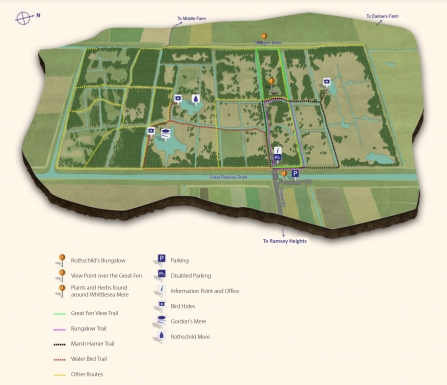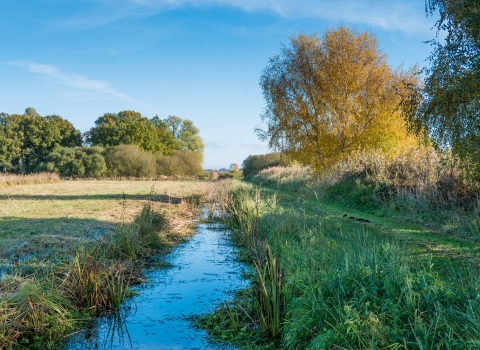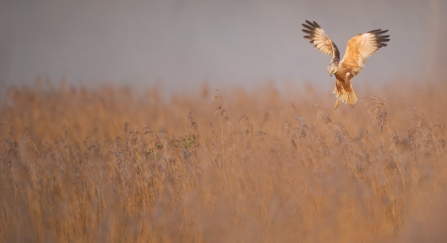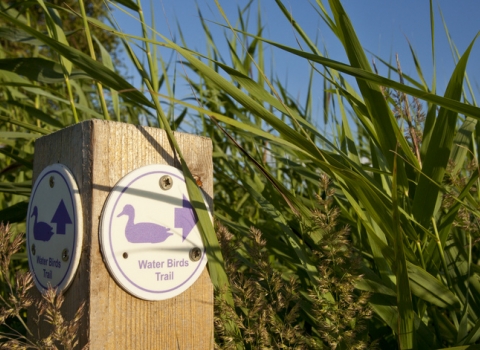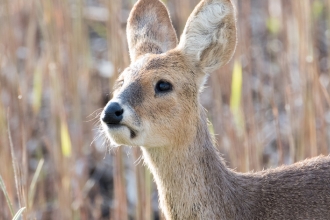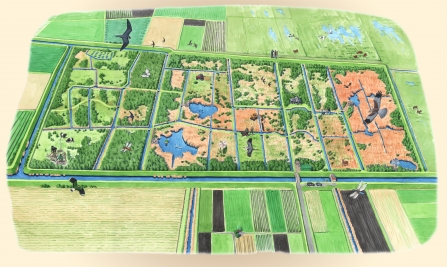
The Great Fen - Woodwalton Fen Map
Woodwalton Fen
Woodwalton Fen is owned by the Wildlife Trust BCN and is managed by Natural England and is one of only four remaining fragments of the ancient wild fens that once stretched for 1,350 square miles across the area and is a last haven for many rare fen species.
This beautiful reserve is internationally important for wildlife and provides a refuge for thousands of species of fen animals and plants, many of which are found nowhere else in the country. It is a National Nature Reserve, a Ramsar site, a Site of Special Scientific Interest (SSSI) and a Special Area of Conservation (SAC).
Explore peaceful paths through the reeds while listening to the calls of birds, watch dragonflies dart along the water's edge and discover the Rothschild Bungalow. The reserve is a paradise for nature lovers, photographers and a window into a lost world.
Update 20.01.2025: Some paths are closed for winter due to water levels, please follow diversions on site. We regret to inform you that Rothschild's hide is now closed to the public as the access bridge has been found to be structurally unsafe.
History Highlights
The ancient wild fens once stretched for miles across a huge part of East Anglia, but more than 99% of the habitat disappeared when the land was drained for agriculture. Now one of only four remaining fragments of the ancient fens, Woodwalton Fen would not exist today if it were not for Charles Rothschild, a successful banker, wildlife enthusiast and "father of modern conservation".
Becoming very concerned with the rapid disappearance of British wildlife and habitats as a result of industrialisation, he saw that in order to protect wildlife species and their habitats, nature reserves would need to be established. Rothschild bought Woodwalton Fen in 1910 to ensure that at least one part of the ancient fens would not disappear forever.
Building on the work done by Rothschild and his colleagues, Natural England, the governments adviser on nature conservation (previously the Nature Conservancy Council, then English Nature) designated the first National Nature Reserves in 1953, and in 1954 Woodwalton Fen was designated as a National Nature Reserve. These are some of the best sites in the country for wildlife and geology.
During the late 1960's - mid 1980's, the Middle level Commissioners implemented proposals for an improved farmland drainage system locally, designating Woodwalton Fen as a flood storage reservoir. As part of the agreement with the Middle level Commissioners, the Nature Conservancy Council allowed MLC to construct clay cored banks on the reserve boundary, an act that significantly improved water retention on the reserve with huge benefits for the wetland habitats and species.
The Rothschild Bungalow
On the site of an old farmstead and at the heart of the new nature reserve, Charles Rothschild built a bungalow on stilts and used it as a base for his field trips out on the fen. His activities included moth trapping at night and local people were not quite sure what to make of the visitors from London who went out into the fen at night with lanterns. You can still visit the bungalow today.
Wildlife Trust - The Great Fen. Rothschild Bungalow
Wildlife
It was the incredible array of invertebrate life that attracted Charles Rothschild. More than 1000 beetle species of terrestrial and aquatic have been recorded in the reserve, of which nearly 200 are rare in Britain. More than 900 species of moths and butterflies have been recorded, including the Elephant Hawk Moth and Marsh Carpet Moth.
There are more than 400 species of wildflowers that can be found on the nature reserve, particular importance is the Fen Violet, found in only two other places the UK and the Fen Woodrush, found nowhere else in the country.
Kingfishers breed and can be seen along the dykes and around the meres at any time of year. A highlight of Woodwalton Fen is the aerial display of Marsh Harriers over the northern reed bed. The Marsh Harrier almost died out as a UK breeding species just a few decades ago due to persecution, however since the 1960's the population has recovered to an estimated 400 breeding pairs.
Woodwalton Fen route map
There are three great trails to help visitors discover the best of this historic nature reserve. See the links below to find out more about each one.
There are also some other paths (marked by yellow dotted lines below) but please note that access to these are liable to change. The yellow dotted path to the North East (top right of this map) is now closed and those crossing through the south fields have no access most of the year due to cattle.
The arrows to Manor Farm and Darlow's Farm are for reference only as there are no permissive access routes now.
